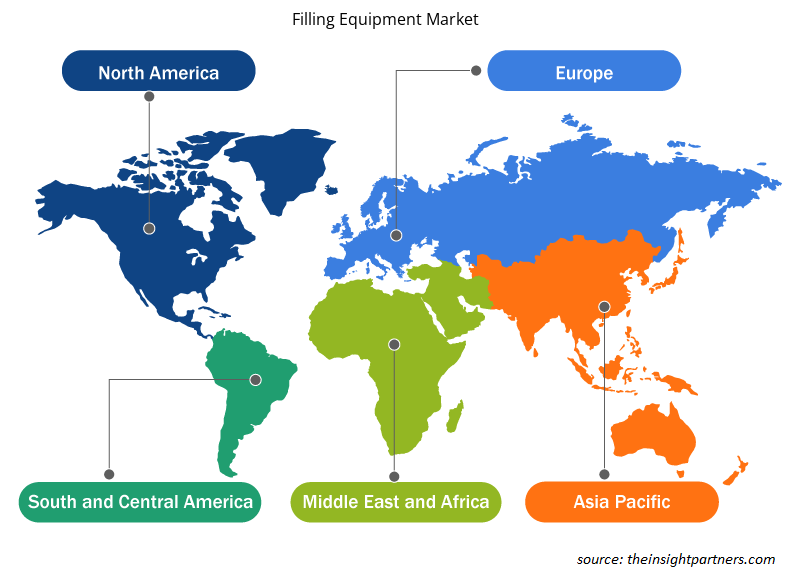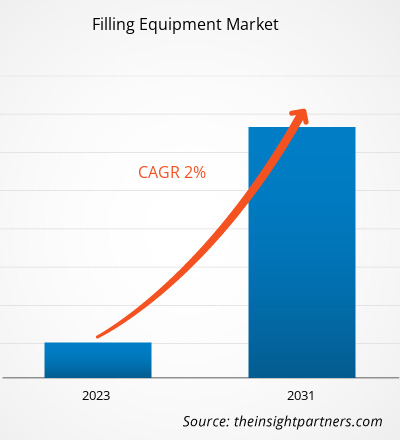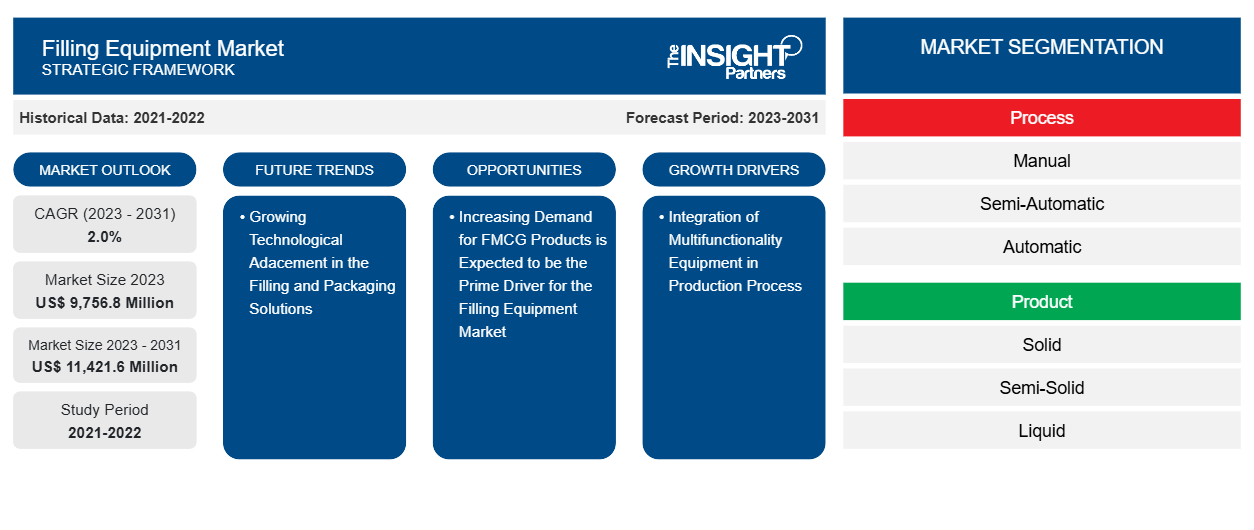Si prevede che la dimensione del mercato delle attrezzature di riempimento raggiungerà 11.421,6 milioni di $ USA entro il 2031 da 9.756,8 milioni di $ USA nel 2023. Si prevede che il mercato registrerà un CAGR del 2,0% nel 2023-2031. Un sostanziale sviluppo industriale, la crescente parità di potere d'acquisto dei consumatori e la crescente adozione di tecnologie automatizzate sono i fattori che dovrebbero spingere la crescita del mercato delle attrezzature di riempimento nel periodo di previsione.
Analisi del mercato delle attrezzature di riempimento
Risultati di produzione richiesti, supporto tecnologico avanzato, il minimo intervento umano e l'integrazione di automazione e robotica sono alcuni dei fattori chiave che attirano l'attenzione dei produttori per optare per le attrezzature di riempimento. Le rigide normative governative per le bevande , gli alimenti e le industrie associate stanno spingendo i produttori di macchine di riempimento a selezionare la standardizzazione per affermare la qualità del prodotto e l'igiene richiesta. Inoltre, si prevede che la crescente concentrazione dei consumatori verso prodotti lavorati e confezionati convenienti, la crescita della popolazione, l'aumento del reddito, la crescente urbanizzazione e la consapevolezza della salute guideranno la domanda di attrezzature di riempimento nel periodo di previsione.
Panoramica del mercato delle attrezzature di riempimento
Le attrezzature di riempimento sono le macchine sfruttate per riempire forme solide, semisolide, in polvere e liquide di prodotti in contenitori di contenimento come scatole, sacchetti, bottiglie o buste. Il mercato è classificato in processo, prodotto, utente finale e area geografica. In base al processo, il mercato è suddiviso in manuale, semiautomatico e automatico. In base al prodotto, il mercato è suddiviso in solido, semisolido, liquido e in polvere. Si prevede che il liquido sarà il segmento in più rapida crescita nel periodo di previsione. In base all'utente finale, il mercato è segmentato come farmaceutico, alimentare e delle bevande, cosmetico e altri. La crescente domanda di attrezzature di riempimento nel settore FMCG è uno dei principali fattori trainanti per il mercato. Tuttavia, le elevate spese di installazione e manutenzione possono ostacolare la crescita del mercato in alcune applicazioni.
Personalizza questo report in base alle tue esigenze
Riceverai la personalizzazione gratuita di qualsiasi report, comprese parti di questo report, o analisi a livello nazionale, pacchetto dati Excel, oltre a usufruire di grandi offerte e sconti per start-up e università
-
Scopri le principali tendenze di mercato in questo rapporto.Questo campione GRATUITO includerà analisi di dati che spaziano dalle tendenze di mercato alle stime e alle previsioni.
Driver e opportunità del mercato delle attrezzature di riempimento
Si prevede che la crescente domanda di prodotti FMCG sarà il motore principale del mercato delle apparecchiature di riempimentoFMCG Products is Expected to be the Prime Driver for the Filling Equipment Market
L'evoluzione del settore dei beni di largo consumo (FMCG) nei paesi sviluppati e in via di sviluppo, dovuta al crescente numero di nuovi attori, dovrebbe spingere la domanda di riempimento del mercato delle attrezzature a livello globale. Il crescente numero di produttori di prodotti FMCG in tutto il mondo crea un'ampia domanda di tecnologie di riempimento e confezionamento, che, a sua volta, aumenta l'applicazione del mercato delle attrezzature di riempimento. Il riempimento e il confezionamento sono diventati una parte importante del marchio del prodotto. I produttori stanno investendo molto in tecnologie di riempimento e confezionamento standard per mantenere l'igiene e stare al passo con le linee guida governative. Il confezionamento di un prodotto dimostra un ruolo cruciale in quanto attira principalmente l'attenzione del consumatore verso qualsiasi prodotto. Pertanto, la crescente proliferazione del marchio e del marketing del prodotto, insieme all'attenzione sull'automazione dei processi per l'efficienza dei tempi operativi, stanno agendo come fattori trainanti principali per il mercato delle attrezzature di riempimento.FMCG) industry in developed and developing nations, owing to the growing number of new players, is anticipated to propel the demand for filling the equipment market globally. The growing number of FMCG product manufacturers worldwide creates extensive demand for filling and packaging technologies, which, in turn, boosts the application of the filling equipment market. Filling and packaging have become a major part of the product branding. Manufacturers are investing highly in standard filling and packaging technologies to maintain hygiene to keep pace with government guidelines. The packaging of a product demonstrates a crucial role as it primarily draws consumer attention towards any product. Thus, the growing proliferation of product branding and marketing, along with the focus on process automation for operational time efficiency, are acting as major driving factors for the filling equipment market.
Crescente progresso tecnologico nelle soluzioni di riempimento e confezionamento
Si prevede che la crescente attenzione all'automazione dei processi e il crescente progresso tecnologico nelle soluzioni di imballaggio e riempimento offriranno grandi opportunità per le apparecchiature di riempimento in vari settori come alimenti e bevande, prodotti farmaceutici, FMCG e prodotti chimici, tra gli altri. Si stima inoltre che la crescente adozione di IoT, intelligenza artificiale e sistemi di monitoraggio dei dati da parte dei produttori di prodotti per migliorare l'efficienza operativa e i tempi di produzione guiderà la crescita del mercato delle apparecchiature di riempimento nel periodo di previsione.FMCG, and Chemicals, among others. Increasing adoption of IoT, artificial intelligence, and data monitoring systems by product manufacturers to enhance operational efficiency and production time is also estimated to drive the filling equipment market growth over the forecast period.
Analisi della segmentazione del rapporto di mercato delle attrezzature di riempimento
I segmenti chiave che hanno contribuito alla derivazione dell'analisi di mercato delle apparecchiature di riempimento sono processo, prodotti e utente finale.
- In base al processo, il mercato è stato suddiviso in manuale, semi-automatico e automatico. Il segmento semi-automatico ha detenuto una quota di mercato maggiore nel 2023.
- In base ai prodotti, il mercato è stato suddiviso in solido, semisolido, liquido e in polvere. Il segmento liquido ha detenuto una quota di mercato maggiore nel 2023.
- In termini di utente finale, il mercato è stato segmentato in food & beverage, farmaceutico, cosmetico e altri. Il segmento food and beverage ha dominato il mercato nel 2023.
Analisi della quota di mercato delle attrezzature di riempimento per area geografica
L'ambito geografico del rapporto sul mercato delle attrezzature di riempimento è suddiviso principalmente in cinque regioni: Nord America, Europa, Asia Pacifico, Medio Oriente e Africa e Sud America.
L'Asia Pacifico ha dominato il mercato delle apparecchiature di riempimento nel 2023. La regione Asia Pacifico comprende Cina, Australia, India, Giappone e Corea del Sud. Si prevede che l'elevato sviluppo e la crescente proliferazione di tecnologie avanzate, come le apparecchiature di riempimento semi-automatiche o automatizzate nei centri di produzione di alimenti e bevande, FMCG e prodotti chimici, stimoleranno la crescita del mercato nel periodo di previsione. Anche l'elevata presenza di produttori di apparecchiature di riempimento contribuisce alla crescita del mercato delle apparecchiature di riempimento nell'Asia Pacifico. L'aumento del reddito familiare e la crescente preferenza per cosmetici e prodotti alimentari trasformati stanno supportando lo sviluppo delle industrie alimentari e delle bevande, farmaceutiche e FMCG nell'Asia Pacifico, che a sua volta sta avendo un impatto positivo sul mercato nella regione. Poiché le apparecchiature di riempimento svolgono un ruolo cruciale nel processo di produzione dei prodotti, le aziende manifatturiere si stanno concentrando molto sull'incorporazione di apparecchiature di riempimento di fascia alta per mantenere l'igiene e l'efficienza operativa. Pertanto, si prevede che la crescente attenzione allo sviluppo di nuovi prodotti e al progresso tecnologico stimolerà la crescita del mercato nell'Asia Pacifico.
Approfondimenti regionali sul mercato delle attrezzature di riempimento
Le tendenze regionali e i fattori che influenzano il mercato delle attrezzature di riempimento durante il periodo di previsione sono stati ampiamente spiegati dagli analisti di Insight Partners. Questa sezione discute anche i segmenti e la geografia del mercato delle attrezzature di riempimento in Nord America, Europa, Asia Pacifico, Medio Oriente e Africa e Sud e Centro America.

- Ottieni i dati specifici regionali per il mercato delle attrezzature di riempimento
Ambito del rapporto di mercato sulle attrezzature di riempimento
| Attributo del report | Dettagli |
|---|---|
| Dimensioni del mercato nel 2023 | 9.756,8 milioni di dollari USA |
| Dimensioni del mercato entro il 2031 | 11.421,6 milioni di dollari USA |
| CAGR globale (2023-2031) | 2,0% |
| Dati storici | 2021-2022 |
| Periodo di previsione | 2023-2031 |
| Segmenti coperti |
Per processo
|
| Regioni e Paesi coperti |
America del Nord
|
| Leader di mercato e profili aziendali chiave |
|
Densità degli attori del mercato: comprendere il suo impatto sulle dinamiche aziendali
Il mercato delle attrezzature di riempimento sta crescendo rapidamente, spinto dalla crescente domanda degli utenti finali dovuta a fattori quali l'evoluzione delle preferenze dei consumatori, i progressi tecnologici e una maggiore consapevolezza dei vantaggi del prodotto. Con l'aumento della domanda, le aziende stanno ampliando le loro offerte, innovando per soddisfare le esigenze dei consumatori e capitalizzando sulle tendenze emergenti, il che alimenta ulteriormente la crescita del mercato.
La densità degli operatori di mercato si riferisce alla distribuzione di aziende o società che operano in un particolare mercato o settore. Indica quanti concorrenti (operatori di mercato) sono presenti in un dato spazio di mercato in relazione alle sue dimensioni o al valore di mercato totale.
Le principali aziende che operano nel mercato delle attrezzature di riempimento sono:
- Azienda di attrezzature per l'imballaggio Accutek, Inc.
- COESIA SpA
- Gruppo GEA AG
- Società JBT
- Azienda KHS GmbH
Disclaimer : le aziende elencate sopra non sono classificate secondo un ordine particolare.

- Ottieni una panoramica dei principali attori del mercato delle attrezzature di riempimento
Notizie e sviluppi recenti sul mercato delle attrezzature di riempimento
Il mercato delle attrezzature di riempimento viene valutato raccogliendo dati qualitativi e quantitativi dopo la ricerca primaria e secondaria, che include importanti pubblicazioni aziendali, dati associativi e database. Di seguito è riportato un elenco degli sviluppi nel mercato delle attrezzature di riempimento e delle strategie:
- A giugno 2021, ACMA lancia, che fa parte di COESIA SpA, un'azienda che ha introdotto "Ecoshell", una tecnologia di imballaggio sostenibile a base di carta, realizzata specificamente per l'industria dolciaria. (Fonte: ACMA, Comunicato stampa/Sito web aziendale/Newsletter)
- Nel marzo 2024, GEA Group Aktiengesellschaft ha presentato una nuova applicazione web basata sul cloud, specificatamente per i prodotti di lavorazione e confezionamento alimentare, alla fiera Anuga FoodTec. (Fonte: GEA Group Aktiengesellschaft, comunicato stampa/sito web aziendale/newsletter)
Copertura e risultati del rapporto sul mercato delle attrezzature di riempimento
Il rapporto "Dimensioni e previsioni del mercato delle attrezzature di riempimento (2021-2031)" fornisce un'analisi dettagliata del mercato che copre le seguenti aree:
- Dimensioni e previsioni del mercato a livello globale, regionale e nazionale per tutti i segmenti di mercato chiave coperti dall'ambito
- Dinamiche di mercato come fattori trainanti, vincoli e opportunità chiave
- Principali tendenze future
- Analisi PEST dettagliata
- Analisi di mercato globale e regionale che copre le principali tendenze di mercato, i principali attori, le normative e gli sviluppi recenti del mercato
- Analisi del panorama industriale e della concorrenza che copre la concentrazione del mercato, l'analisi della mappa di calore, i principali attori e gli sviluppi recenti
- Profili aziendali dettagliati con analisi SWOT
- Analisi storica (2 anni), anno base, previsione (7 anni) con CAGR
- Analisi PEST e SWOT
- Valore/volume delle dimensioni del mercato - Globale, Regionale, Nazionale
- Industria e panorama competitivo
- Set di dati Excel
Report recenti
Testimonianze
Motivo dell'acquisto
- Processo decisionale informato
- Comprensione delle dinamiche di mercato
- Analisi competitiva
- Analisi dei clienti
- Previsioni di mercato
- Mitigazione del rischio
- Pianificazione strategica
- Giustificazione degli investimenti
- Identificazione dei mercati emergenti
- Miglioramento delle strategie di marketing
- Aumento dell'efficienza operativa
- Allineamento alle tendenze normative























 Ottieni un campione gratuito per - Mercato delle attrezzature di riempimento
Ottieni un campione gratuito per - Mercato delle attrezzature di riempimento